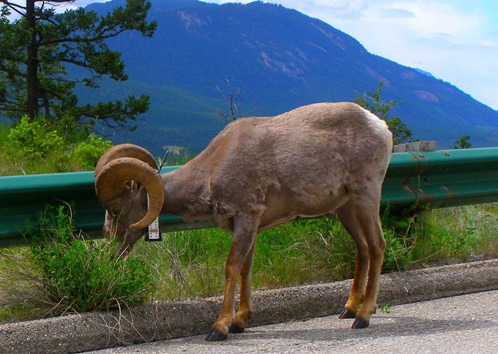Wildlife that makes itself comfortable in human habitats usually proves troublesome — an ongoing problem that a large herd of sheep have presented to the Village of Radium.
“We’re losing close to ten per cent of the herd every year on the highway,” Alan Dibb told The Valley Echo. Mr. Dibb works as a Wildlife Biologist for Banff, Yoho, and Kootenay National Parks of Canada.
Radium residents have also complained about an excess of sheep stool, which they say is causing odours, health concerns and visual discomfort.
Rather than culling or hazing the sheep out of town, Parks Canada is taking a proactive approach by attempting to lure the sheep into ideal habitats.
“Part of our motivation is to try and provide alternative habitat on the east side of the highway, so the sheep don’t have to cross the highway so much where they risk getting struck by vehicles,” Mr. Dibb said.
Parks Canada has undertaken an experimental approach called the Redstreak Restoration Project, which will address three objectives. The three goals of the group are to “enhance Rocky Mountain bighorn sheep habitat by restoring grasslands and open forest structure,” “to reduce dangerous forest fuel levels in and around Redstreak Campground,” and, “to create a fire guard on the east side of the Redstreak Campground.”
The first objective mentioned is “partially motivated by an interest in providing habitat options for sheep away from highways so that sheep-vehicle collision rates might be reduced,” Mr. Dibb said.
The project began in 2002 and is still underway. Mr Dibb said mechanical fitting was the first step, which was the removal of trees.
“We tended to remove most of the smaller trees and left most of the veteran trees, then burned a significant portion of the area in both 2005 and 2009 to prevent conifer encroachment.”
He said that by opening the forest up and removing obstacles, Parks Canada is mimicking the natural process of fire to promote growth among plants that are important to bighorn sheep habitats.
“Basically, we just have this thick conifer forest, full of pine, spruce and fir trees that developed and grew quite thickly, and it reduces the amount of grass, herbaceous vegetation and shrubs that can grow in the forest.”
Radio collars were attached to a sample of sheep at the beginning of every year until 2009, which allowed Parks Canada to track their movements before and during the restoration project.
“In 2002, the average animal spent less than two days per year in the restoration area,” he said. “After 2002, over the next six years, the range was from 4.3 days per year to 17 days per year.”
He said that while the increased time spent in the project area after the restoration is a fairly substantial difference, “it’s not enough for the average person to think to themselves, “Gee, the sheep sure aren’t spending much time in the village anymore.””
The restoration efforts are an attempt to coax the sheep into congregating in a more suitable habitat than the Village of Radium. Granting the sheep a new place to live has proven a challenge, as the village has provided the herd favourable living conditions.
“They’re attracted to the high-quality forage that’s available in town, like the grass on the golf course and the residential lawns,” Mr. Dibb said. “There may also be an effect of trying to avoid predators by being in the townsite.”
Curious hikers who would enjoy checking out the restoration area can find it by taking the Redstreak Road towards the Redstreak Campground. The trail starts in behind the campground.
Hikers are best to ask for directions from the campground kiosk, Mr. Dibb said.
